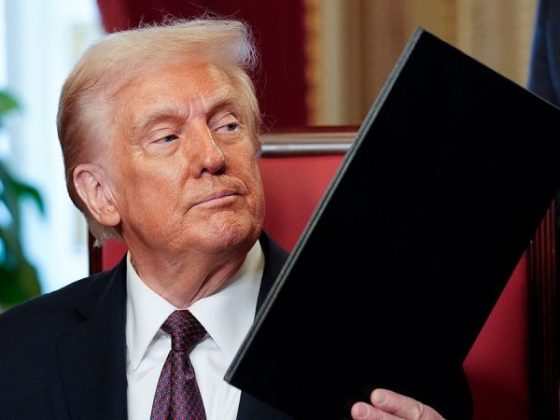Diversification remains crucial for investors navigating the commodity markets amid geopolitical uncertainties and global trade tensions.
As market volatility increases, driven in part by potential trade conflicts between the US and China, investment demand is expected to support the prices of several key commodities, particularly metals.
The growing global shift away from fossil fuels is also driving a significant rise in power demand.
Consequently, metals and raw materials essential for power generation are likely to see sustained demand in the coming years.
To gain insights into current commodity market trends and risk management strategies, Invezz spoke with Ole Hansen, head of commodity strategy at Saxo Bank.
For novice investors, Hansen recommends broad exposure through ETFs that track major commodity indices, such as the Bloomberg Commodity Index.
This strategy provides diversification and helps mitigate volatility compared to investing in individual commodities.
Hansen favors decarbonization metals like copper and aluminum over construction metals.
He also sees increasing demand for power-related commodities, such as uranium and natural gas, driven by data centers and climate change concerns.
Edited excerpts:
Invezz: What are the key trends you’re observing in the commodity markets, and how do you see these evolving over the next year?
Well, there are a few short-term and some long-term trends that we are looking at right now.
And the short-term one is not surprisingly the developments that come out of Washington.
We’re seeing oil prices trading unchanged compared with the levels at the start of the year after a $10 per barrel surge.
But also the trend is one of a world, not in disarray, but a troubled world and for various reasons.
And that’s strengthening the hand of something like gold.
We have some major trends in the coming years, which I think is likely, which it already has, but also will continue to underpin prices for commodities.
Ultimately commodities are not just a question of demand, it’s also supply.
Supply, to a certain extent in some areas, could get challenged in the coming years.
But we have if you take some of the most important ones, something like de-globalisation, which is most certainly ongoing right now.
After decades of globalization, we are now decoupling.
It’s creating two poles, two centers of the world, China on one side, and the US on the other.
And then with big emerging economies like India and Europe somewhere stuck in the middle between these two.
We have a lot of increased spending on defense, which is commodity-intensive.
We have the whole decarbonization process, which is also adding underlying support for several key commodities.
We have the de-dollarisation, which has gathered momentum after Russia invaded Ukraine back in 2022.
We’re seeing central banks increasingly trying to reduce their dependency on the dollar by buying gold.
So central bank demand for gold has been extremely strong, and that probably looks set to continue.
We have the whole AI (artificial intelligence) craze).
The rollout of data centers, the increased demand for power in the coming years, and what that means for several commodities.
The period from 2000 to 2008, when China entered the world stage and began purchasing vast quantities of raw materials, was what we would call a “super cycle.”
It’s not the kind of pace we’re looking at, but still an underlying demand for commodities.
The investment perspective should also be considered. What are investors looking at right now?
Well, they’re all trying to be part of the technology boom and the rally we’ve seen there. But that’s also creating some markets that are really quite overvalued where there are some concerns.
The world is heavily indebted, and there are fiscal concerns.
Additionally, there might be some returning inflationary concerns due to tariffs and their potential impact on prices.
And this leads to, I would say, inflation becoming stickier at a higher level than we probably had seen before.
And again, in an environment of inflation, then you seek tangible assets from an investment perspective.
So, the physical demand for several key metals and commodities is expected to remain strong in the coming years.
Additionally, investment demand is likely to support prices due to ongoing market uncertainties.
Investors may also shift their focus away from traditional assets like stocks and bonds, further driving interest in these commodities.
Investment strategies
Invezz: For someone looking to invest in commodities for the first time, what would be your advice on how to start?
Investors first need to understand the risks and volatility that commodities present.
However, if some of the views I have shared here are the drivers, then investors may want to consider broad exposure to commodities.
The range of investment products available has expanded significantly over the past decade.
There are now several easily accessible ETFs that track major commodity indices.
I personally follow the Bloomberg Commodity Index the most. I like it because it has roughly one-third exposure to agriculture, metals, and energy.
I like that kind of diversification as opposed to some of the others where it’s more based on trade, where there’s a higher percentage exposure in energy.
And that may not necessarily be where I see the biggest upside. So I’ll cast my eye on ETFs.
By doing that you’re spreading yourself across the whole spectrum and lowering the kind of volatility that you see in the daily price movements.
As opposed to just having exposure to coffee or cocoa.
Invezz: What commodities offer the best growth potential in the current economic climate, and why?
If you look at metals then obviously we still have a firm view that gold and silver prices will move higher.
If you look at industrial metals, it’s most certainly, I would say, the decarbonization of metals over construction metals.
So, I prefer copper and aluminum over something like iron ore and steel, depending on if there’s really big spending towards the defense then the steel demand will be quite solid but generally it’s a favor of copper and aluminum.
As I said earlier, crude oil is mostly going to be rangebound.
Where we see the big pickup in demand in the coming years for energy is on the power front.
The power demand will keep rising due to factors like data centers and increased cooling needs in certain regions as the climate warms.
This will drive the need for raw materials used to generate power, such as uranium and gas.
Despite a push for cleaner energy, we’re still seeing record levels of coal consumption, particularly in Asia.
The power demand will keep increasing, meaning we will need to produce more of it in the coming years.
On the agricultural side, it’s difficult to predict anything because it’s so weather-dependent.
However, we’ve seen this past year that food commodities produced in relatively small geographical areas are extremely vulnerable to changes in the weather.
We saw that in cocoa prices in West Africa. We’re seeing that right now with coffee prices making one record after another because of adverse and lower production in Brazil.
The last few years have seen very good production years for key crops like corn, wheat, and soybeans, leading to high inventories and lower prices.
However, we’ve recently started to see prices increase for corn and soybeans, and this trend could continue if there are production issues in the Northern Hemisphere over the next six months.
Invezz: What is your view on gold hitting $3,000? Do you think it is possible?
We lowered our target for gold prices from $3,000 per ounce to $2,900 per ounce in December simply because of the slowing pace of interest rate cut expectations for this year.
But I think still $3,000 is most certainly within sight.
And, if we should get to that kind of level, then we could see silver do even better, perhaps reach up towards the higher $30s or hit somewhere between $38 and $40.
We remain quite bullish on those simply because of the multiple supporting factors.
US tariffs
Invezz: What is your estimate about the impact of US tariffs on Canada’s energy imports?
Well, if it does come back, and it’s been taken off the table just for now, postponed just like the Mexican tariffs were postponed as well.
But if they are introduced again, it will create some bottlenecks, potentially, especially in the northern parts of the US, where the refineries are very dependent on oil coming down from Canada.
And it also highlights that the US is not oil independent, simply because the oil they produce themselves is not necessarily the quality that the refineries need to refine all the different products that are in demand, because it’s not only diesel and gasoline.
There are a lot of other products, chemicals, heavy-grade fuels plastic, and so on.
And, that means that the Canadian crude is a different quality.
That’s also the reason why the US imports roughly 4.5 million barrels of crude oil from Canada and Mexico.
But at the same time, they export around 4 million barrels as well.
And you would say that’s almost like a zero-sum, but it just highlights there’s a quality difference, which makes them dependent on imports from Canada and Mexico.
So what it would mean if they are introduced is obviously that prices on Canadian crude will go up by 10%.
The question is who is going to carry that cost and probably speculation is that it would be more or less equally carried between the seller, the producer in Canada, and the refineries in the US having to pay a higher price.
But ultimately, it will translate into regional higher prices for some of the refined products.
OPEC’s strategy
Invezz: What do you think the Organization of the Petroleum Exporting Country and allies’ strategy will be in April when they are scheduled to raise oil output?
Well, that’s going to be balancing the market on a knife’s edge.
But what we have seen at least in the early parts of January, was quite a higher level of consumption than anticipated.
The projected surplus is likely to shrink, though not completely disappear, reducing the excess supply expected earlier.
Sanctions on Russia are affecting buyers in Asia, while potential new sanctions on Iran could also have an impact.
Despite existing restrictions, Iran has increased its oil production by over a million barrels per day during Biden’s presidency.
And if that starts to be reversed, or partly reversed, then that will leave room for a steady increase from other OPEC producers.
At this point, OPEC is heading towards a tapering of the production cuts from April. But in terms of actual barrels, it’s going to be relatively small amounts rolled out over time.
I don’t think that the impact is going to be that aggressive.
The risk is, and that’s why I think we’re back to square one now in terms of price action this year.
The risk is clear if we have a trade war.
A global trade war will hurt the overall level of growth and energy demand. So that is the key.
OPEC is not scheduled to raise production until April, which means they will need to re-evaluate the situation in March.
Hopefully, by then, there will be more clarity on the direction of the tariff war, including whether Europe will become involved and what countermeasures might be implemented.
Based on this, it should be possible to better anticipate the overall impact on global demand.
At the beginning of the year, we forecasted that the Brent crude oil price would range between $65 and $85 per barrel.
Currently, it is trading around $75, the middle of our range, and we will stick to that target.
We believe the downside is limited because while the US will try to facilitate greater oil production, oil-producing companies will ultimately focus on a couple of key factors.
The limitations on US production increases are based on several factors.
These include the expected forward price, the price for the investment put into new production, and the expectations for demand in the coming years.
Additionally, if prices drop into the $60s, some established projects may become uneconomical, leading to a slowdown in US production.
Therefore, it’s likely that the market has a natural ceiling in the mid-60s.
The only factor that could push prices back up to the 85 range is a supply disruption.
Invezz: Do you think OPEC remains relevant today?
I think well they have been in the last few years because if they hadn’t been for their active management of oil production, then we would have at certain points seen crude oil prices trade sharply lower.
They have managed to be quite successful in maintaining stable prices.
Although prices have stabilized, they are lower than desired. And that’s partly down to OPEC’s policies.
By keeping production lower, they have allowed non-OPEC+ producers to increase production.
The primary reason for this year’s negative price predictions is that non-OPEC+ production increases are expected to surpass the total increase in demand.
And part of that is OPEC’s own doing, because they have actually kept prices perhaps higher than where they otherwise would have been. That has invited additional production growth.
But whether they’re relevant going forward, over time, it will become more and more difficult for the group, simply because at some point we will start to see global oil demand rollover.
The timing of this rollover is going to be critical in terms of OPEC’s ability to manage prices and manage production.
And in the coming years, that quest will become increasingly difficult.
So I’ll say for now, they have been very successful, but over time probably it’s going to be more difficult to maintain this kind of stability.
Impact of AI on commodity trading
Invezz: How do you see technological advancements, like blockchain or AI, affecting the commodity trading landscape?
The AI crisis is first and foremost one about data; the immense amount of data that needs to be available to produce all these magnificent solutions.
This requires raw materials, and a lot of focus on the power-generating companies, and the companies building power-generating facilities.
That’s why we’ve seen a very, very strong rally in stocks across companies that are involved in this build-up.
And, that I think will only continue, even though we saw a correction with the DeepSeek news.
But generally, that trend will likely continue.
The impact on overall demand is uncertain, but for now, the focus remains on expanding capacity, which will require many commodities, especially metals.
The post Interview: Diversifying into commodities mitigates risks amid global uncertainties, says Saxo Bank’s Ole Hansen appeared first on Invezz


